Site blog

COLOGNE, April 6, 2020 – The European Union Aviation Safety Agency (EASA) has published the first view worldwide on the use and control of drones in an urban environment, balancing the desire to maximise the commercial and convenience benefits of drones against the need to ensure the safety and privacy of citizens and the potential environmental impact on our cities.
The challenge of integrating drones into urban environments is that these areas are already densely used by ground traffic, other types of air traffic – such as commercial airplanes, other civil aviation and police or hospital helicopter services – and also people, concerned about noise, privacy and the possibility of low-level flights causing accidental injury.
The term “U-space” has been adopted to describe the management of unmanned aircraft traffic to ensure the safe interaction with other entities using the same space in any location, not just urban areas.
“We are already starting to see an increasing number of complex flights undertaken by drones in various experiments across the globe. Also, as everyone is aware, many companies have commercial ambitions to use drones for deliveries or, looking further ahead, to offer services such as air taxis,” said Patrick Ky, Executive Director of EASA.
“This opinion proposes a regulatory framework that will allow such services to co-exist with all the other activities in our urban environments. The aim is to ensure safe operations, while also creating the basis for a competitive U-space services market, and establishing a level of environmental protection, security and privacy that is acceptable to the public.”
The opinion, presented to the European Commission as a basis for future legislation, lays down the first building block for the establishment of the U-space in Europe. The initial scope is low level airspace, densely-populated urban airspace and locations close to an airport, with no attempt made to cover the airspace in other areas. EASA expects to expand the scope as the market develops and experience is gained.
One example of the measures it proposes is a Common Information Service for exchange of essential information. This would offer U-space service providers, air navigation service providers and other participants in the U-space airspace access to the same traffic data and airspace restrictions. This will help drone operators to plan and execute their flights safely, knowing exactly where and when their drone is permitted to fly.
Together with the opinion, EASA published a first set of draft content of acceptable means of compliance (AMC) and guidance material (GM) to support drone operators and EU member states in complying with the new rules. The final AMC & GM will be published by EASA once the European Commission has adopted the regulation and once the necessary consultation with stakeholders has been completed.
Opinion 01/2020 – High-level regulatory framework for the U-space
By Press
ALEXANDRIA, VA – April 2, 2020 – As the nation enters the upcoming growing season in the midst of the ongoing COVID-19 pandemic, the National Agricultural Aviation Association (NAAA) is asking all Unmanned Aircraft System (UAS) operators to be extra mindful of low-flying manned agricultural aircraft operations.
“The Department of Homeland Security (DHS) declared crop input services to be an essential service during the pandemic. Aerial applicators are inputting nutrients, seeds and crop protection products to crops that will become consumers’ food and fiber supply. We cannot afford even a small disruption in the nation’s food supply chain during this critical time,” said Andrew Moore, Chief Executive Officer of NAAA. “Agricultural aviators perform applications on 28% of cropland nationwide, and their work cannot be delayed because of an unidentified UAS not yielding to them, as is required by law.”
Agricultural aviators fly as low as 10 feet off the ground, meaning they share airspace with UAVs that are limited to flying no more than 400 feet above ground level. For this reason, NAAA is asking UAV operators to do everything they can to avoid ag aircraft doing important, low-level work.
NAAA recommends that UAS operators:
Equip drones with tracking technology, such as ADS-B, so other aircraft similarly equipped know of their positions.
Get certified and well-trained in operating a UAV.
Contact local agricultural aviation operations before flying by consulting AgAviation.org/findapplicator.
Equip UAVs with visible strobe lights.
Give the right-of-way to a manned aircraft. It’s the law.
Land your UAV immediately when a low-flying aircraft is nearby.
Carry UAV liability insurance.
In a test conducted by the Colorado Agricultural Aviation Association and other stakeholders, including manned and unmanned aircraft organizations, and the state of Colorado, no pilot operating a manned aircraft could continuously visually track a 28-inch-wide drone when flying at regular speeds. While they might be spotted for a second, UAVs are not constantly visible to pilots, meaning it’s up to the drone operator to avoid a collision.
When birds hit an ag aircraft, they can break through an aircraft’s windshield causing deadly accidents. A study conducted by the Alliance for System Safety of UAS through Research Excellence (ASSURE) showed UAV collisions with aircraft cause more damage than would a bird strike of similar size, due partially to UAVs’ dense motors and batteries, as opposed to a bird made mostly of water, feathers, hollow bones and sinew.
At this moment in time especially, when we’re all depending on the continued safe, affordable and abundant food, fiber and biofuel, don’t forget our nation’s agricultural aviators are working in the skies to help farmers produce it. If you’re going to fly a UAV this summer, please be responsible and do everything you can to avoid agricultural aircraft.
Learn more at AgAviation.org
By Press
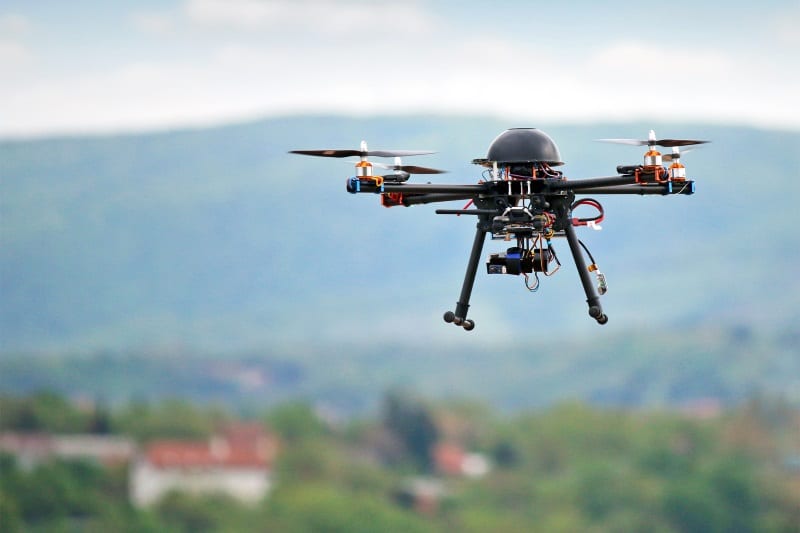
The American National Standards Institute (ANSI) has released a working draft of Version 2.0 of the Standardization Roadmap for Unmanned Aircraft Systems for public review and comment. The roadmap is being developed by ANSI’s Unmanned Aircraft Systems Standardization Collaborative (UASSC).
The UASSC aims to coordinate and accelerate the development of the standards and conformity assessment programs needed to facilitate the safe integration of UAS into the national airspace system, with international coordination and adaptability. It is focused on the use of UAS in civil, commercial, and public safety applications.
The roadmap identifies existing standards and standards in development, defines where gaps exist, and recommends additional work that is needed, including a timeline for its completion and organizations that can perform the work. It is intended to help clarify the current standardization landscape, minimize duplication of effort among standards development organizations (SDOs), help inform standards participation, and facilitate the growth of the UAS market.
Issues addressed in the roadmap include airworthiness, flight operations, personnel training, qualifications and certification, infrastructure inspections, environmental applications, commercial services, workplace safety, and public safety operations. The document also includes brief introductions to the UAS activities of the Federal Aviation Administration (FAA), other U.S. federal government agencies, SDOs, and industry.
Specific goals for Version 2 of the document include expanding the content to include topics such as spectrum, urban air mobility, and recreational operations; engaging subject matter experts not previously involved; identifying potentially overlooked gaps; tracking progress by standards developers to address the roadmap’s recommendations; reviewing priorities; and otherwise incorporating feedback.
ANSI president and CEO S. Joe Bhatia commented: “The UASSC has continued to make considerable progress over the past year to identify the standards needed to support the increasing use of UAS for civil, commercial, and public safety operations. At this time we are inviting comments from the broad community of stakeholders to inform the further development of the document.”
The draft roadmap can be downloaded from the ANSI website here.
By Mike Ball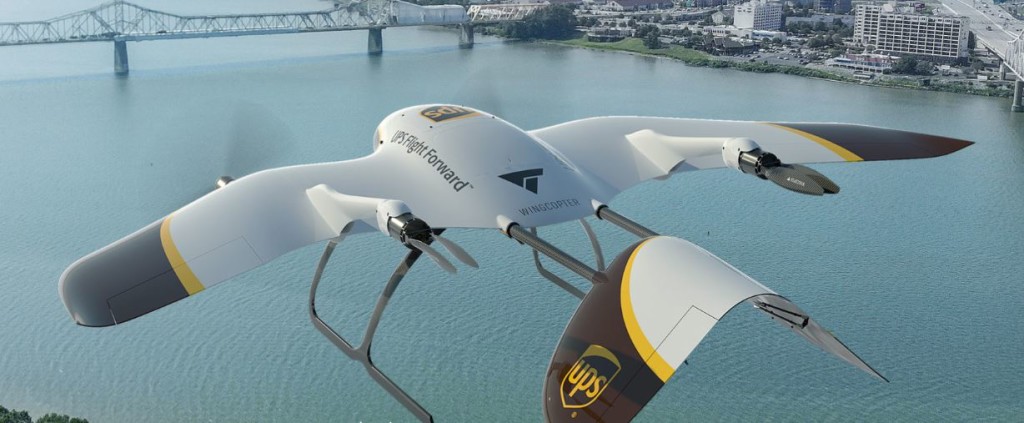
Four years ago, during my first Commercial UAV Expo in Las Vegas, I came across a group of young people with an idea that I thought at the time would revolutionize the concept of electric vertical take off and landing or eVTOL. Their young company, Wingcopter, based in Darmstadt, Germany was in the process of perfecting Tilting, a technical challenge that has haunted the infamous Boeing Osprey V22, since its first flight in the late 80’s. Their innovative design was one of the many revelations of the 2016 Commercial UAV Expo and from then on, they have moved to bigger and better things as they perfected their technology.
On March 24, Wingcopter and UPS drone delivery subsidiary UPS Flight Forward (UPSFF) announced that they would collaborate to develop the next generation of package delivery drones for a variety of use cases in the United States and internationally. We reached out to Tom Plümmer, CEO of Wingcopter, for his perspective on the UPS announcement, but also to talk about the future of drone delivery in general.
What markets are you looking at apart from the UPS partnership?
We are currently focusing on different delivery applications like the efficient and safe transport of healthcare products such as vaccines, blood, medicines or laboratory samples, packages (e-commerce), food or groceries. We are looking at applications that can be carried out either in a commercial, a humanitarian or an emergency context. However, the Wingcopter is even more versatile: Wingcopters are also used throughout the world for mapping and inspection purposes. For example, one of our customers, Norwegian company KVS Technologies, uses a fleet of Wingcopters for autonomous power line inspections.
Is your technology available to the general public today?
Yes, we have been selling our Wingcopters and also renting them on a subscription basis to private corporations, organizations, government entities and public customers for more than two years. That allowed us to be completely self-financed and bootstrapped, building up Wingcopter purely through revenue, until recently when we received two venture capital investments to accelerate the company’s development and global expansion. Despite the partnership with UPS, Wingcopter continues to be an independent drone manufacturer, open for all kinds of business cooperation with other customers.
What kind of support issues are you having with your technology?
We are in close contact with all our customers and even offer customized solutions on request. We include in every order an equipment introduction and flight training. In many cases, we even help to set up our customers’ projects. For a startup, this can of course be challenging at times, especially when operating globally. However, we are in the good position to have a really good relationship with most customers, sometimes even friendly contact, and that we get constructive feedback enabling us to constantly improve and stay innovative.

From the UPS perspective, we reached out to Kyle Peterson, UPS spokesperson, who was able to shed some light as the reasons to select Wingcopter.
“Wingcopter’s patented tilt-rotor configuration combines the benefits of two drone types in one unmanned system. It offers the ability to take off and land vertically in the smallest of spaces like a quadcopter/multicopter. It also has the ability to transition smoothly into an efficient fixed-wing aircraft, enabling flights over longer distances, higher payloads and high speeds,” Peterson said. “In addition, Wingcopter’s slow-drop mechanism allows drones to lower parcels accurately through a secure winch while hovering, avoiding the need to land at the point of destination. Finally, Wingcopter has a track record of delivering a variety of goods over long distances in multiple international settings.”
The versatility, endurance capabilities, and longevity of Wingcopter stood out to Bala Ganesh, VP of UPS Advanced Technology Group, who saw the partnership with Wingcopter as a way to establish new drone delivery use cases.
“Drone delivery is not a one-size-fits-all operation,” Ganesh stated in his original press release. “Our collaboration with Wingcopter helps pave the way for us to start drone delivery service in new use cases. UPS Flight Forward is building a network of technology partners to broaden our unique capability to serve customers and extend our leadership in drone delivery.”
As part of this collaboration, UPSFF’s first new relationship with a drone manufacturer since its formation, both companies will work toward earning regulatory certification for a Wingcopter unmanned aircraft to make commercial delivery flights in the United States. It is also a critical step toward building a diverse fleet of drones with varying capabilities to meet even more potential customer needs.
During these trying times as the world is fighting a global pandemic of enormous proportions, news of partnerships like this one between an established company such as UPS and a young startup like Wingcopter, brings hope to those of us who see drone delivery as a great way to maintain social distancing.
If their technical and logistic proposal makes sense from the economic and safety point of view, regulators around the world will have no choice but to look closely and expedite flights that would allow life-saving deliveries to isolated communities.
By Juan Plaza,
Europe’s drone market is expected to build up to 10 billion euros a year by 2035, topping 15 billion euros by 2050
SUGUS is a European Commission project that aims to speed up the takeup of Europe’s GNSSs to ensure safe airspace access by unmanned aircraft Using EGNOS and Galileo, the project sets out to ensure safe and efficient coexistence of manned and unmanned air traffic
Madrid, 27 March 2020.- GMV has been awarded the SUGUS project (Solution for E-GNSS USpace Service), which aims to speed up the takeup of GNSS and Galileo in the Unmanned Aerial Vehicle (UAV) segment. SUGUS, an 18-month, 485,000-euro, European Union R&D project, is to be carried out by a GMV-led consortium involving also Everis Aerospace, Defense and Security, VVA Brussels, ESSP, FADA-CATEC and Unifly.
SUGUS will help to develop services geared towards the effective integration of drones in the airspace. A series of trials will be held to show the benefits of E-GNSS for drone operators as well as its approval by aviation authorities.
The demand for UAV services is steadily increasing, with the potential to generate significant economic growth, as recognized in the 2015 European Union Aviation Strategy. More recently, the 2016 SESAR (Single European Sky ATM1 Research) Drones Outlook Study estimated that the European drone market will clock up 10 billion euros a year by 2035 and over 15 billion euros annually by 2050.
U-Space is a set of new airspace-management services and procedures designed to ensure unmanned aircraft’s airspace access while looking out for operational security, the right to privacy and the safety of persons and infrastructure. These services rely on a high level of digitization and function automation, whether onboard the drone itself or part of the ground based environment.
Several initiatives are now underway at European level to develop U-Space and work towards the safe and efficient coexistence of manned and unmanned air traffic. At the same time the new European legislation on operating unmanned systems has now come into force, providing a uniform, Europe-wide framework.
SUGUS tasks
Europe is a worldwide pioneer in bringing in common drone legislation. This regulation is broken down into three drone operation categories: Open, calling for no AESA clearance or operator declaration; Specific, where both clearance and declaration will be necessary; and Certified, reserved for riskier operations.
To be able to develop services designed to integrate drones into the airspace, SUGUS will center on the Open and Specific flight categories.
SUGUS will demonstrate the benefits for drone operations of the measures implemented at service-provision level and the new EGNSS API (Application Programming Interface) to be implemented in the project. These benefits included the mitigation of operating risks, improvement of preparation processes and clearance of the operator’s mission. Such measures as expected to ease future urban aerial mobility (UAM) operations, such as aero taxis or parcel delivery.
As the first step in this endeavor, SUGUS will carry out a review of the results of previous EGNSS projects while also pinpointing the needs of drone operators and unmanned traffic service providers in complex operations and built-up areas. This analysis will help to define and then implement the new E-GNSS-based API. SUGUS will also be running several flight trials in complex environments to prove the benefits of the drone-operation measures. The overarching idea is to raise awareness and contribute towards drone standardization and regulation in order to maximize the chances of the proposed services being implemented as a USpace service.
By Press
Governments and researchers around the world are working on new solutions for pandemics in the current Covid-19 crisis. Drones have been important tools for applications including drone delivery and disinfection – but in this project, Canadian drone solutions company Draganfly will act as systems integrator with a healthcare data services company and researchers in Australia, developing a drone to help health officials immediately identify an outbreak. The proposed “pandemic” drone would be able to fly over people and identify their temperature and respiratory conditions, helping to limit infections.
The need for rapid identification of people infected with the disease so that they can quarantine and limit further infection has become abundantly clear in the Novel Coronavirus disaster, as current testing tools can be slow and have limited availability. A drone that could immediately survey community groups could be a game changer for healthcare officials.
This picture shows the data that the drone could capture:
The following is a Draganfly press release.
Draganfly Selected to Globally Integrate Breakthrough Health Diagnosis Technology Immediately onto Autonomous Camera’s and Specialized Drones to Combat Coronavirus (COVID-19) and Future Health Emergencies
Partnering with The University of South Australia developers of the technology in collaboration with the Australian Department of Defence – Defence Science and Technology Group
Vancouver, British Columbia – March 26, 2020 (GLOBE NEWSWIRE) – Draganfly Inc. (CSE: DFLY) (OTCQB: DFLYF) (FSE: 3U8) (“Draganfly” or the “Company”), an award-winning, industry-leading manufacturer within the commercial Unmanned Aerial Vehicle (“UAV”), Remotely Piloted Aircraft Systems (“RPAS”), and unmanned vehicle sector, today announced that it has been selected as the exclusive global systems integrator for a project (the “Vital Intelligence Project”) with Vital Intelligence Inc., a healthcare data services & deep learning company in conjunction with the University of South Australia, using technology developed with help from the Australian Department of Defence Science and Technology Group (the “DST”).
The Vital Intelligence Project is a health and respiratory monitoring platform involving utilizing new and existing camera networks as well as UAVs and RPAS being immediately commercialized for health monitoring and detection of infectious and respiratory conditions including monitoring temperatures, heart and respiratory rates, amongst crowds, workforces, airlines, cruise ships, potential at-risk groups, i.e., seniors in care facilities, convention centers, border crossings or critical infrastructure facilities. The breakthrough technology was developed in a collaboration between the University of South Australia and the DST.
Draganfly, in being selected as the exclusive integration partner on March 25, 2020, executed a binding agreement which has an initial budget of up to $1.5M to utilize its engineering, integration and distribution expertise as well as its secure supply chain for immediate commercialization and deployment of the technology.
Dr. Javaan Chahl, Defence Science and Technology Chair at the University of South Australia said, “The University and Defence supported my team’s efforts to develop automation for use in epidemics and disasters. We had imagined the technology being used in a future relief expedition to some far-away place. Now, shockingly, we see a need for its use in our everyday lives immediately. Draganfly’s industrial know-how is quickly helping us ensure our research can save lives.”
“Draganfly has been selected because of its proven leadership in an industry so important to public safety at such a critical time. We look forward to working with global agencies and industry to rapidly deploy this important technology,” said Cameron Chell, CEO of Draganfly.
“Draganfly is honored to work on such an important project given the current pandemic facing the world with COVID-19. Health and respiratory monitoring will be vital for not only detection, but also utilizing the data to understand health trends. As we move forward, drones and autonomous technology doing detection will be an important part of ensuring public safety,” said Andy Card, Director of Draganfly and former Secretary of Transportation and White House Chief of Staff.
Dr. Jack Chow, advisor to the Vital Intelligence Project and the former first Assistant Director-General of the World Health Organization (WHO) on infectious diseases said: “With fighting epidemics rising as a global priority, new versatile technologies, such as humanitarian mission UAVs, are immediately needed to detect and track outbreaks so that critical interventions can be deployed sooner and with greater effectiveness.”
About University of South Australia
The University of South Australia (UniSA) is a public research university in the Australian state of South Australia. It is a founding member of the Australian Technology Network of universities and is the largest university in South Australia with approximately 32,000 students. UniSA is among the world’s top universities, ranked in the World’s Top 50 Under 50 by both the Quacarelli Symonds (QS) World University Ranking (#25) and Times Higher Education (THE) (#26). Under the University’s Act, its original mission was “to preserve, extend and disseminate knowledge through teaching, research, scholarship and consultancy, and to provide educational programs that will enhance the diverse cultural life of the wider community”.
About Draganfly
Draganfly Inc. (CSE: DFLY; OTCQB: DFLYF; FSE: 3U8) is the creator of quality, cutting-edge, UVS and software that revolutionizes the way people do business. Recognized as being at the forefront of technology for over 21 years, Draganfly is an award-winning, industry-leading manufacturer within the commercial UAV and UVS space, serving the public safety, agriculture, industrial inspections and mapping and surveying markets. Draganfly is a company driven by passion, ingenuity and the need to provide efficient solutions and first-class services to its customers around the world with the goal of saving time, money and lives.
For more information on Draganfly, please visit us at draganfly.com.
By: Miriam McNabb, Drone Life
A ‘pandemic drone’ to remotely monitor and detect people with infectious respiratory conditions is being developed by the University of South Australia (UniSA) in partnership with a Canadian company.
The drone will be fitted with a specialised sensor and computer vision system that can monitor temperature, heart and respiratory rates, as well as detect people sneezing and coughing in crowds, offices, airports, cruise ships, aged care homes and other places where groups of people may work or congregate.
The UniSA team led by Defence Chair of Sensor Systems Professor Javaan Chahl, who holds a joint appointment DST, will work with Draganfly Inc, a North American drone technology company, to immediately start integrating commercial, medical and government customers.
Professor Chahl, working alongside Dr Ali Al-Naji and Asanka Perera, achieved global recognition in 2017 when they demonstrated image-processing algorithms that could extract a human’s heart rate from drone video.
Since then they have demonstrated that heart rate and breathing rate can be measured with high accuracy within 5-10 metres of people, using drones and at distances of up to 50 metres with fixed cameras. They have also developed algorithms that can interpret human actions such as sneezing and coughing.
He says the technology could be a viable screening tool for the COVID-19 pandemic.
“It might not detect all cases, but it could be a reliable tool to detect the presence of the disease in a place or in a group of people.”
Professor Chahl says the technology was originally envisaged for war zones and natural disasters as well as remotely monitoring heart rates of premature babies in incubators.
“Now, shockingly, we see a need for its use immediately, to help save lives in the biggest health catastrophe the world has experienced in the past 100 years.”
Draganfly CEO Cameron Chell says his company will use its sensor, software and engineering expertise to work with UniSA to integrate and deploy for government, medical and commercial customers.
“We are honoured to work on such an important project given the current pandemic facing the world with Covid-19. Health and respiratory monitoring will be vital not only for detection but also to understand health trends,” Mr Chell says.
By Press
Image credits: toricigs
Almost all of us have been quarantined for the past couple of weeks. For single people, it’s a real date stopper. Well, this guy found a perfect solution for that.
Jeremy Cohen noticed a girl dancing on the roof of a building next to his own house in Brooklyn. When she saw him, he waved and she waved back. Jeremy then sent a drone her way and that’s how this romantic story started. Bored Panda asked what inspired this romantic gesture, Jeremy told us: “I actually haven’t been on a date in at least a year. I think I was just craving some social interaction, and being confined by the walls of my apartment inspired some creativity for me.”

Image credits: jerm_cohen
Jeremy himself
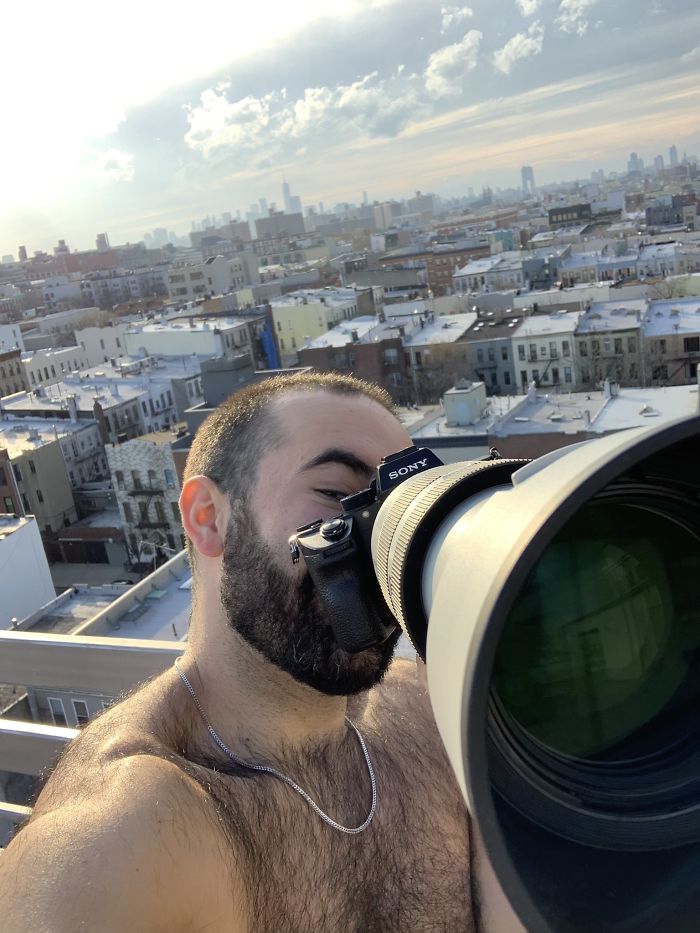
Image credits: jerm_cohen
Jeremy told us what’s it been like for him the in quarantine: “I’m all cooped up in my apartment alone, so its definitely different than my normal life of being out and about all the time (there’s so much to do in NYC!) For now, I’m taking it day by day.” Well, thankfully he found something to occupy his mind during these hard times.
He noticed a girl dancing on the roof of the building next to his home

Image credits: jerm_cohen
“I looked out my window and saw this girl dancing, perhaps to a TikTok song? I needed to say ‘Hi’ to her.”

Image credits: jerm_cohen
He waved at her and she waved back

Image credits: jerm_cohen
“So I waved to her on my balcony and she waved back.”
Tori—the girl from the roof

Image credits: toricigs
He took his drone
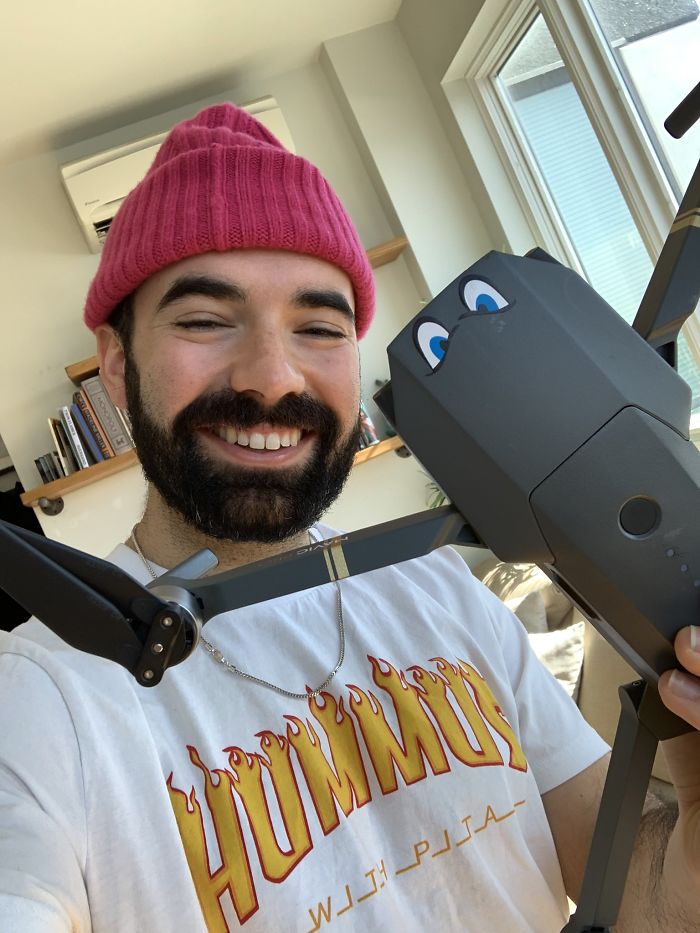
Image credits: twitter.com
Attached a piece of paper to it
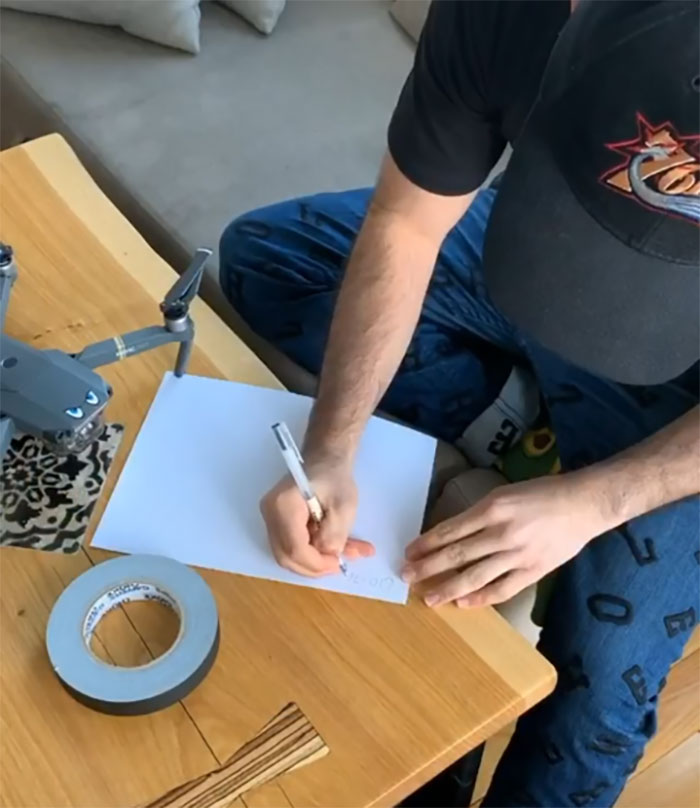
Image credits: jerm_cohen
“I grabbed my tape, pen, drone, and paper. Then I wrote down my digits and sealed them on my drone. Flirting is normally daunting for me, but since I’ve been quarantined in my apartment for a week now, I was screaming for social interaction.”
With his number and “text me” written on it
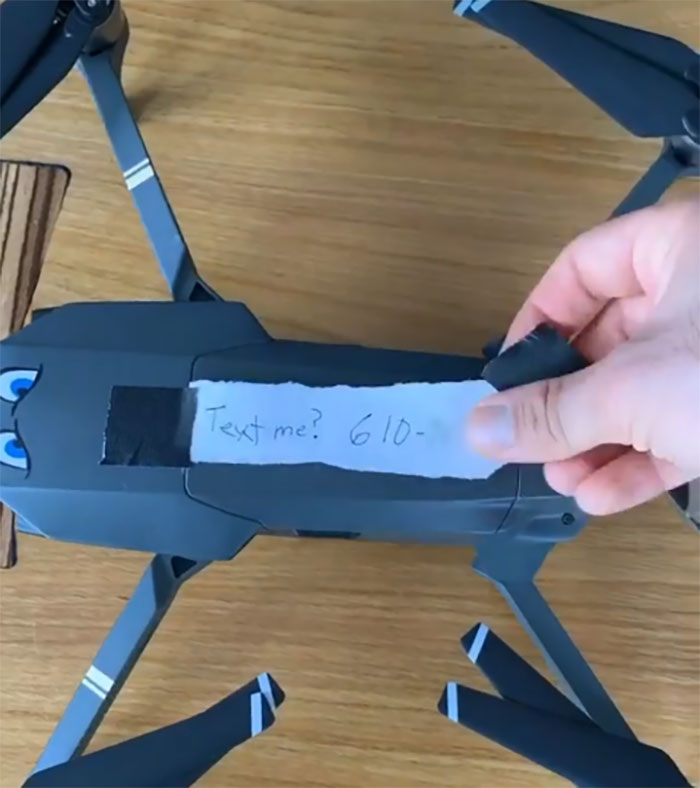
Image credits: jerm_cohen
He sent it out
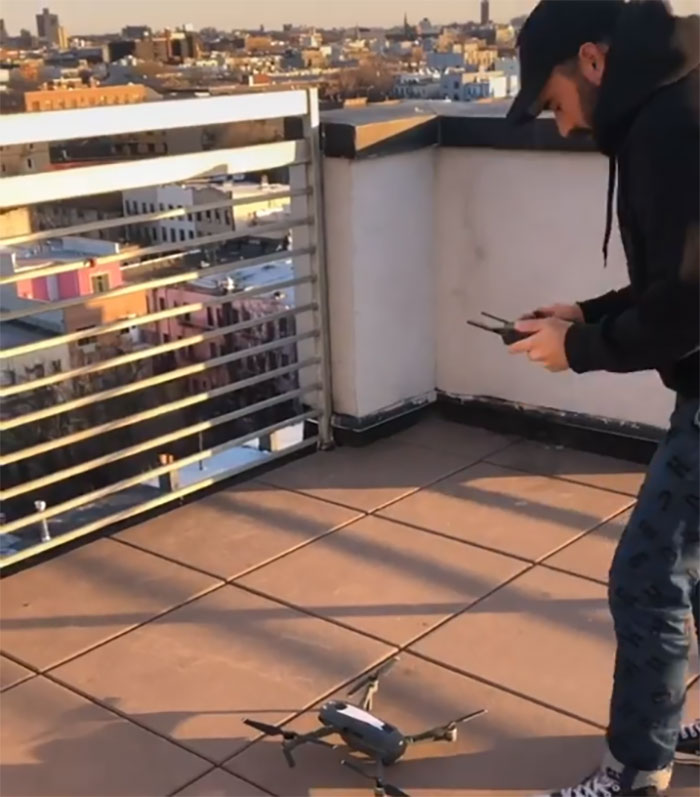
Image credits: jerm_cohen
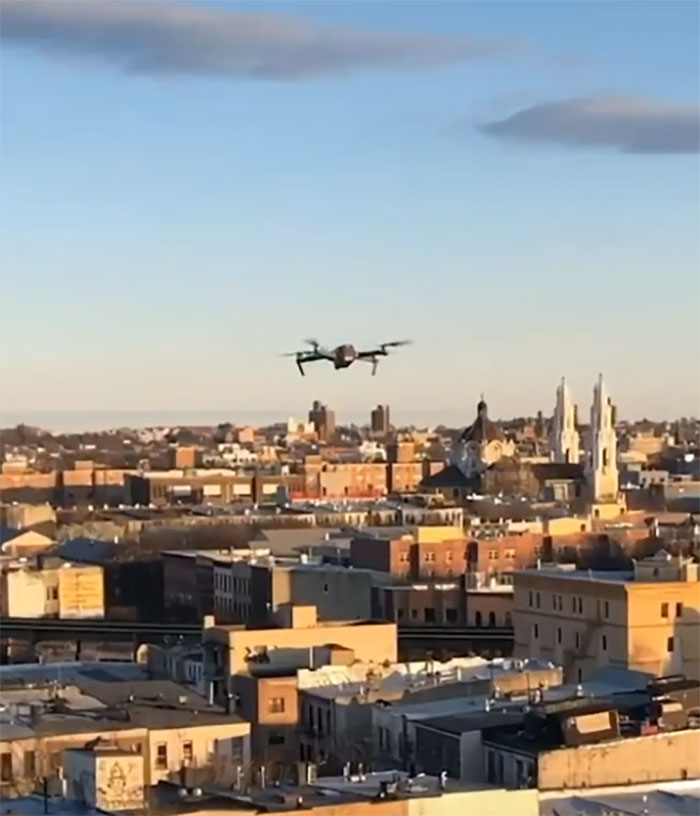
Image credits: jerm_cohen
Tori was really surprised
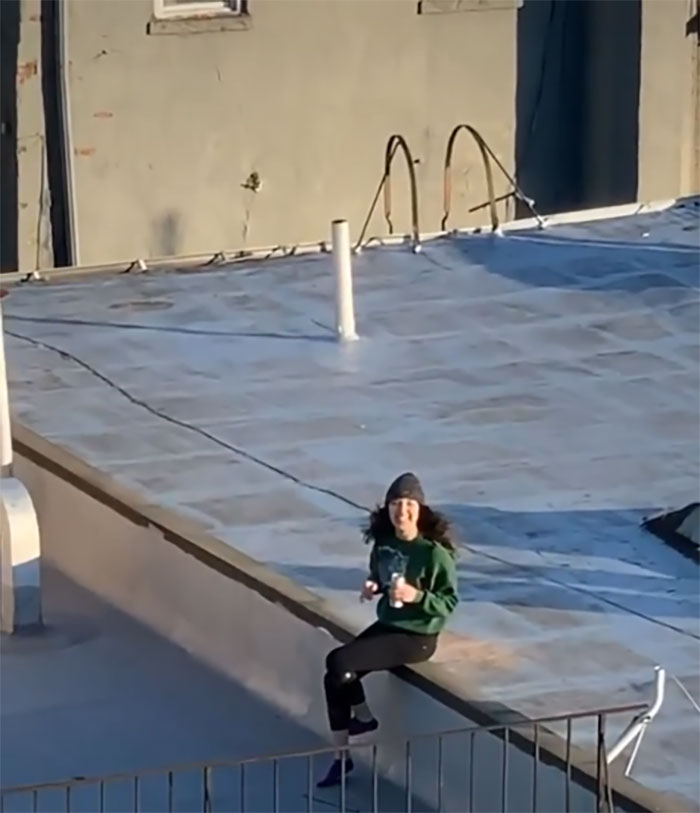
Image credits: jerm_cohen
“2020 has been off to a terrible start, but I still needed to shoot my shot. She picked up my drone and I guess it worked because I got a text from her an hour later.”
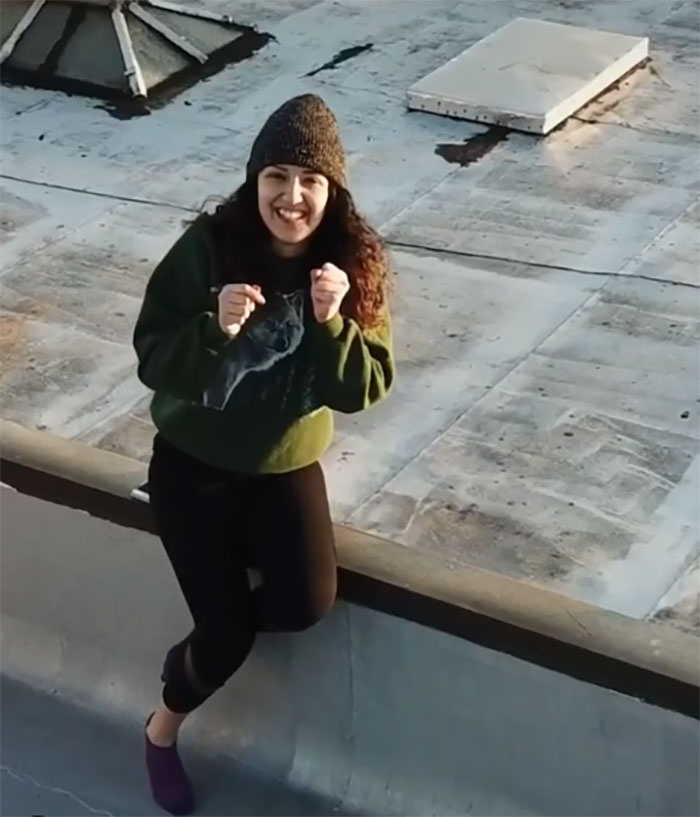
Image credits: jerm_cohen
And after a few moments texted him!

Image credits: jerm_cohen
The next day, Jeremy decided to ask her out. However, Tori wondered how that would work

Image credits: jerm_cohen
“I still can’t believe this happened the other day. Now it’s time for part two. I asked her out for dinner, but she said ‘How?'”
30 minutes before the date, Jeremy and Tori’s roommate organized the whole thing
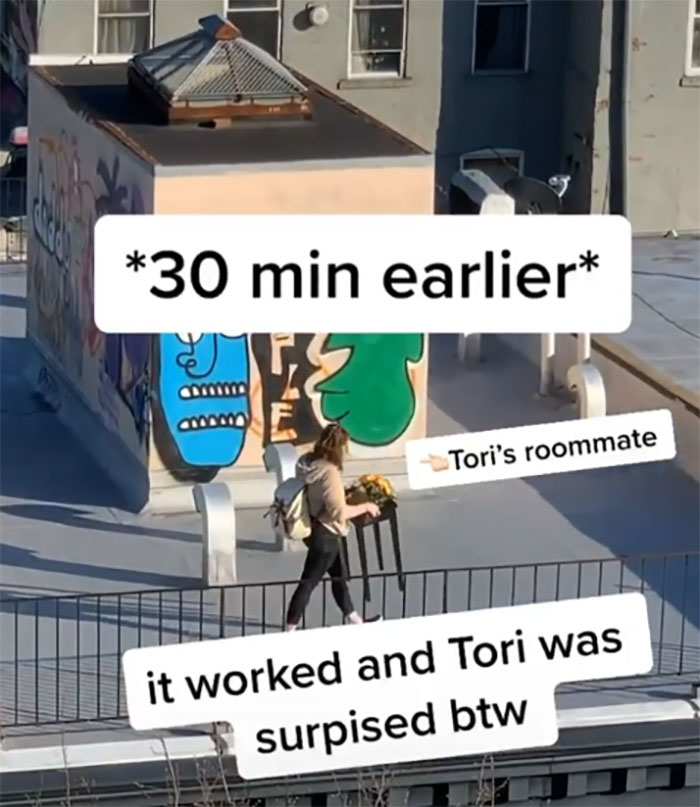
Image credits: jerm_cohen
“I sneakily coordinated with her roommate earlier to set it up.”
Jeremy sat in his balcony and Tori on the roof, following the rules of social distancing

Image credits: jerm_cohen
“5 PM hits. It was time for our date. Wait, where is she? Just kidding. We follow the rules. I waved down at the balcony, she waved back.”
Since Jeremy’s a professional photographer, he took some pictures of her

Image credits: todayiphotographed

Image credits: todayiphotographed
He still wanted to be a gentleman

Image credits: jerm_cohen
“I told her she looked beautiful. So we got on FaceTime and ate our matching organic, microwaved single dinners together.”

Image credits: jerm_cohen
Jeremy told his friends that everything is going great

Image credits: jerm_cohen
“The date was going so well and depending on how long this quarantine lasts, I might be in a long-distance relationship with someone who lives across the street from me. I excused myself to the bathroom. Of course, I didn’t have to go, I just wanted to tell my group chat how well this was going.”
We asked Jeremy how’s it going with Tory now, he said: “So far so good, we had our first date two days ago which went super well. Going on our second date soon. Its a little strange with all the pressure of everyone watching compared to a normal date, but I think I can handle it!”
By Hidrėlėy and Aelita Senvaitytė, Boredpanda
ARPAS-UK is coordinating a National “COVID-19″ Drone Capability Taskforce for the drone industry.
Behind the scenes we are working hard to push the capabilities of the drone industry and making sure that Government Departments are reminded of the expertise and capabilities of the Drone community in the UK.
Whilst we are considering several areas where drones could be used, we are particularly looking to relieve the current and future stress on resources in the Emergency Services. We are also looking at areas such as delivery of emergency food and medicine to vulnerable people, spraying of disinfectant, collection of imagery & video to help monitor various situations.
There are also current activities which could be expanded in scope because they reduce the risks to deliver vital inspections necessary to keep infrastructure running or maintain safety. These could include monitoring following flood or environmental activity and monitoring gas levels on sites.
It is also worth emphasising that drone operations do not involve large groups and reduce human presence directly on the ground and personal contact.
Note as a part of our GDPR commitment, but balancing the need to help where we can, the secure database created with this information will be destroyed when no longer required. If you could fill out the following, it would be really appreciated.
===========================
So, in preparedness for any possible callout, this is a request to the entire drone industry to ask whether you could help fight the battle against Coronavirus. We are aware there are 1000’s of Commercial Drone Operators out there, we may need your help.
By Press
General Atomics Aeronautical Systems, Inc. (GA-ASI) and the Air National Guard (ANG) have signed a contract for GA-ASI to supply its Detect and Avoid System (DAAS) for one MQ-9 Block 1 and one MQ-9 Block 5 Remotely Piloted Aircraft (RPA).
“Our Detect and Avoid System has been extensively tested and not only meets, but exceeds the capabilities of the air traffic awareness and avoidance systems used on today’s commercial airliners,” said David R. Alexander, president, GA-ASI. “The DAAS is an integral part of the certification effort that will allow RPA from GA-ASI to fly in non-segregated, controlled airspace.”
The DAAS consists of GA-ASI’s Due Regard Radar (DRR) and processor, and a Traffic Alert and Collision Avoidance System (TCAS). For the ANG, GA-ASI will upgrade the software in the DRR to add a tactical weather mode, in addition to the air traffic surveillance capability. GA-ASI’s DAA system also enables safe access to uncontrolled airspace and will comply with Due Regard procedure when operating in international airspace.
The DAAS avionics will be integrated into the new Centerline Avionics Bay (CAB). The CAB provides additional volume and mission infrastructure for integrating future capabilities. The CAB’s modular design and additional infrastructure will enable the MQ-9 Block 1 and Block 5 aircraft to be a more open and extensible platform for integration of other emerging capabilities.
About GA-ASI
General Atomics Aeronautical Systems, Inc. (GA-ASI), an affiliate of General Atomics, is a leading designer and manufacturer of proven, reliable Remotely Piloted Aircraft (RPA) systems, radars, and electro-optic and related mission systems, including the Predator® RPA series and the Lynx® Multi-mode Radar. With more than six million flight hours, GA-ASI provides long-endurance, mission-capable aircraft with integrated sensor and data link systems required to deliver persistent flight that enables situational awareness and rapid strike. The company also produces a variety of ground control stations and sensor control/image analysis software, offers pilot training and support services, and develops meta-material antennas. For more information, visit www.ga-asi.com.
By Press